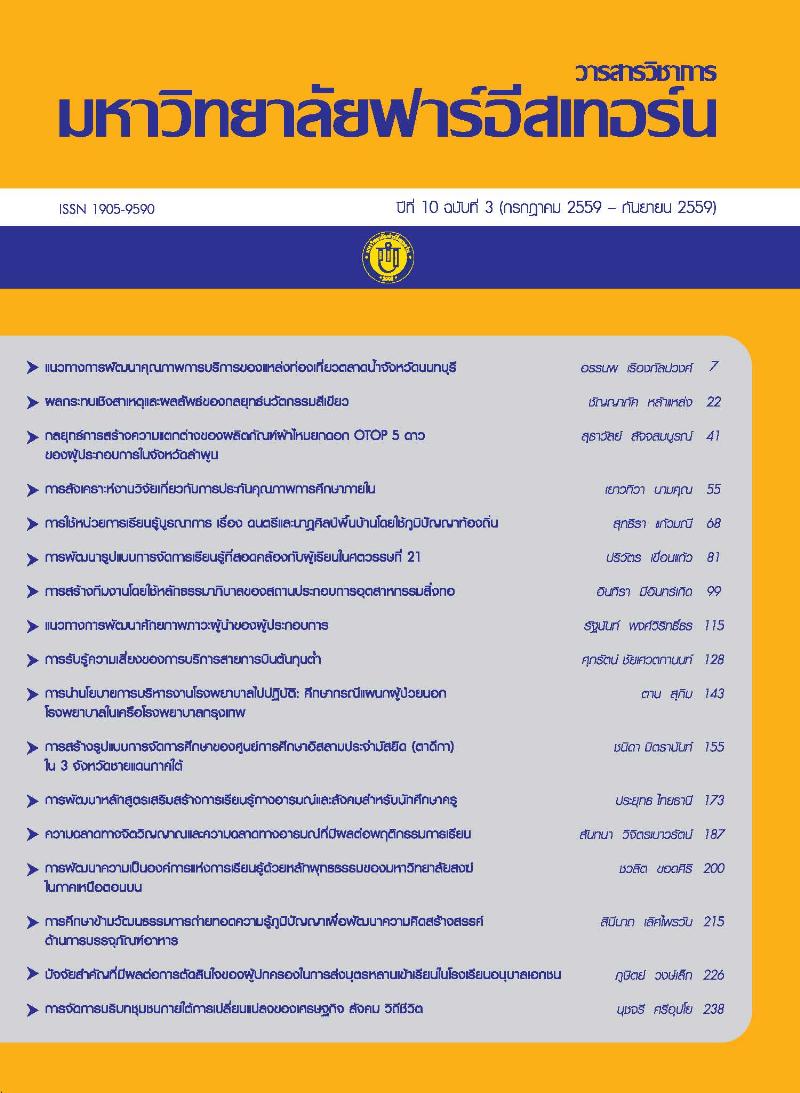การพัฒนารูปแบบการจัดการเรียนรู้ที่สอดคล้องกับผู้เรียนในศตวรรษที่ 21 เพื่อส่งเสริมการคิดเชิงสถิติของนักศึกษาในระดับอุดมศึกษา
Main Article Content
Abstract
การวิจัยในครั้งนี้มีวัตถุประสงค์เพื่อ 1) พัฒนารูปแบบการจัดการเรียนรู้และ 2) ศึกษาผลการใช้รูปแบบการจัดการเรียนรู้ที่สอดคล้องกับผู้เรียนในศตวรรษที่ 21 เพื่อส่งเสริมการคิดเชิงสถิติของนักศึกษาในระดับอุดมศึกษา โดยใช้ระเบียบวิธีวิจัยและพัฒนา มีขั้นตอนการวิจัย 4 ขั้น ได้แก่ ขั้นที่ 1 ร่างรูปแบบการจัดการเรียนรู้ ขั้นที่ 2 พัฒนารูปแบบการจัดการเรียนรู้ ขั้นที่ 3 นำรูปแบบการสอนที่พัฒนาขึ้นไปใช้ ขั้นที่ 4 ปรับปรุงรูปแบบการจัดการเรียนรู้ กลุ่มเป้าหมายที่ใช้ในการวิจัยมี 2 กลุ่ม ประกอบด้วย กลุ่มที่ใช้ในขั้นพัฒนารูปแบบ จำนวน 34 คน และกลุ่มที่ใช้ในขั้นนำรูปแบบการสอนที่พัฒนาขึ้นไปใช้จำนวน 26 คน และผู้มีส่วนได้ส่วนเสียจำนวนทั้งหมด 4 คน ทำการเก็บรวบรวมข้อมูลทั้งเชิงปริมาณและเชิงคุณภาพ ทำการวิเคราะห์ข้อมูลเชิงปริมาณโดยใช้สถิติแบบบรรยาย ข้อมูลเชิงคุณภาพใช้การวิเคราะห์เนื้อหาและทำการสรุปเป็นความเรียง
ผลการศึกษาพบว่า รูปแบบการจัดการเรียนรู้ที่สอดคล้องกับผู้เรียนในศตวรรษที่ 21 เพื่อส่งเสริมการคิดเชิงสถิติของนักศึกษาในระดับอุดมศึกษาที่พัฒนาขึ้นมีชื่อว่า รูปแบบการจัดการเรียนรู้โอไอ มีองค์ประกอบของรูปแบบ 4 องค์ประกอบ ประกอบด้วย 1) ที่มาของรูปแบบการจัดการเรียนรู้ 2) รูปแบบการจัดการเรียนรู้ 3) การนำรูปแบบการจัดการเรียนรู้ไปใช้ และ 4) ผลที่เกิดขึ้นจากการจัดการเรียนรู้
ผลการใช้รูปแบบการจัดการเรียนรู้ พบว่า นักศึกษามีระดับการคิดเชิงสถิติสูงขึ้นในทุกด้านภายหลังได้รับการจัดการเรียนรู้ตามรูปแบบ และมีเจตคติที่ดีต่อการจัดการเรียนรู้ตามรูปแบบการจัดการเรียนรู้
Article Details
1. Any views and comments in the Journal of Social Innovation and Lifelong Learning are the authors’ views. The editorial staff have not to agree with those views and it is not considered as the editorial’s responsibility.
2. The responsibility of content and draft check of each article belongs to each author. In case, there is any lawsuit about copyright infringement. It is considered as the authors’ sole responsibility.
3. The article copyright belonging to the authors and The Far Eastern University are copyrighted legally. Republication must be received direct permission from the authors and The Far Eastern University in written form.
References
เกรียงศักดิ์ เจริญวงศ์ศักดิ์. 2546. คลื่นลูกที่ 5 ปราชญ์สังคม: สังคมไทยที่พึ่งประสงค์ในศตวรรษที่ 21. กรุงเทพฯ : ซัคเซสมีเดีย.
ตะวัน เทวอักษร. 2555. The Flipped Classroom เรียนแบบ “พลิกกลับ” ห้องเรียนยุคใหม่แห่งศตวรรษที่ 21. กรุงเทพฯ: School in focus; 4(11): 17-19.
ธีระชัย ปูรณโชติ. 2554. การเรียนการสอนที่เน้นผู้เรียนเป็นสำคัญ: แนวคิด วิธีและเทคนิคการสอน. กรุงเทพฯ : บริษัท เดอะมาสเตอร์กรุ๊ป แมเนจเม้นท์ จำกัด;2544.
นิรมล ศตวุฒิ. 2547. การจัดการเรียนรู้ที่เริ่มจากผู้เรียน. กรุงเทพฯ : วงการครู. 1(7): 8.
ฟาฏินา วงศ์เลขา. 2556. ห้องเรียนกลับทาง : เปลี่ยนห้องเรียนเป็นพื้นที่เรียนรู้. ได้จาก http://www.dailynews.co.th/Content/education/143051/ห้องเรียนกลับทาง+%3A+เปลี่ยนห้องเรียนเป็นพื้นที่เรียนรู้. (3 มีนาคม 2557).
รามนรี ภูดีบุตร. 2556. การพัฒนากรอบแนวคิดของการคิดเชิงสถิติ. วิทยานิพนธ์ ปริญญาครุศาสตรดุษฏีบัณฑิต สาขาวิชาคณิตศาสตร์ศึกษา. มหาสารคาม : บัณฑิตวิทยาลัย มหาวิทยาลัยราชภัฏมหาสารคาม.
วิจารณ์ พานิช. 2556. ครูเพื่อศิษย์สร้างห้องเรียนกลับทาง. กรุงเทพ : เอสอาร์พริ้นติ้งแมสโปรดักส์ จำกัด.
สุวิทย์ มูลคำ และอรทัย มูลคำ. 2551. 21 วิธีจัดการเรียนรู้ : เพื่อพัฒนากระบวนการคิด. พิมพ์ครั้งที่ 1. กรุงเทพฯ : ภาพพิมพ์.
สุวัฒน์ วัฒนวงศ์. (2544). จิตวิทยาเพื่อการฝึกอบรมผู้ใหญ่. กรุงเทพฯ : เอ็กซเปอร์เน็ท.
สำนักงานคณะกรรมการการศึกษาอุดมศึกษา. 2552. กรอบมาตรฐานคุณวุฒิระดับอุดมศึกษาแห่งชาติ พ.ศ. ๒๕๕๒. กรุงเทพฯ : สำนักงานคณะกรรมการการศึกษาอุดมศึกษา;
Aaron Sams, Jon Bergmann, Kristin Daniels, Brian Bennett, Helaine W. Marshall and Kari M. Arfstrom. 2014. What Is Flipped Learning?. [2 pages]. Available from: URL: http://www.flippedlearning.org/cms/lib07/ VA01923112/Centricity/Domain/46/FLIP_handout_FNL_Web.pdf. 02 April 2014.
Becker, B.J. 1996. A Look at the Literature (and Other Resources) on Teaching Statistics, Journal of Educational and Behavioral Statistics, 21(1), Special Issue: Teaching Statistics, 71-90.
Binnie,N. 2002. Using Project to Encourage Statistical Thinking. [Online]. Available: http://iase-web.org/documents/papers/icots6/10_69_bi.pdf. (05 January 2014).
Boland, P.J. 2003. Promoting Statistical Thinking amongst Secondary School Students in the National Context. The American Statistician. May Vol.57 No.2.
Chance, B.L. 2002. Components of Statistical Thinking and Implications for Instruction and Assessment. Joural of Statistics Education. [online]. Available : http://www.amstat.org/publications/jse/v10n3/chance.html. (05 January 2014).
Dabbagh, 2002, Case Designs for Ill-Structured Problems: Analysis and Implications for Practice. Journal of Educational Multimedia and Hypermedia. 18(2) : 24-29.
Garfield, J. (1993). Teaching Statistics Using Small-Group Cooperative Learning. Journal of Statistics Education, 1(1). http://www.amstat.org/publications/jse/v1n1/garfield.html. (05 January 2014).
Garfield and Ben-Zvi. 2009. Helping Students Develop Statistical Reasoning: Implementing a Statistical Reasoning Learning Environment. Teaching Statistics.
Gould, R., Kreuter, F. and Palmer, C.. 2006. “Toward Statistics Thinking : Making Real Data Real.” Retrieve Mar 20, 2008. [online]. Available : http://www.ime.usp.br/~abe/ICOTS7/ Proceedings/PDFs/InvitedPapers/7A2_GOUL.pdf. (05 January 2014).
Harwell, R., & McCampbell, B. 2002. Using the internet to facilitate problem-based learning. Principal Leadership, 2(6), 63-65.
Howell, David C. 2007. Statistical methods for psychology (6th ed.). Australia; Belmont, CA : Thomson/Wadsworth.
Jones, G.A., Thornton, C.A., Langrall, C.W., Mooney, E., Perry, B., & Putt, I. 2000. A framework for characterizing students’ statistical thinking. Mathematical Thinking and Learning, 2, 269-308.
Joyces, Bruce & Weil, Marsha. (1996). Model of Teaching. 5th ed. Boston : A Simon & Schuster Company.
Julian, M., Kinzie. M.B., and Larsen, V. A. 2000. Compelling Case Experiences: Performance, Practice, and Application For Emerging Instructional Designers.Performance Improvement Quarterly.
Kim, H., and Hannafin, M. 2008. Grounded Design of Web-Enhanced Case-Based Activity. Education Tech Research Dev.
Christopher Keep, Tim McLaughlin and Robin Parmar.1995. The Non-linear Tradition in Literature. [Online] Available: http://www2.iath.virginia.edu/elab/ (10 January 2014).
Lane-Getaz,S.J. 2006. What is Statistical Thinking and How is it Developed?. In G. Burrill, (Ed.), Sixty-eight NCTM Yearbook: Thinking with data and Chance. Reston, VA: National Councill of Teachers of Mathematics.
Moore, D.S. 1997. New Pedagogy and New Content: The Case of Statistics(With Discussion). International Statistical Review.
McGillivray, H. and L. Pereira-Mendoza. 2011. Teaching Statistical Thinking through Investigative Projects. Teaching Statistics in School Mathematics-Challenges for Teaching and Teacher Education.
Oliver, K. (1999). Case-Based Learning. [Online]. Available from: http://www.tutzauer.com/TLC/Case-based_teaching.pdf. (05 January 2014).
Pfannkuch, M. and Wild, C. (2002). Statistical thinking models. [online] Available : http://www.researchgate.net/publication/224013601_Statistical_thinking_models/file/9fcfd50aabe81459e9.pdf. (05 January 2014).
Powell, J.L. 1994. Case Method in Higher Education: A case study. UAS: Kansas State University
Pratt, D. 2008. Statistic Teachers as Designers of Conceptual Space. [Online]. Available: http://iase-web.org/documents/papers/rt2008/Panel3_Pratt.pdf. (05 January 2014).
Roger Hoerl and Ronald D. Snee. (2002). Statistical thinking : improving business performance. Pacific Grove, CA : Duxbury-Thomson Learning.
Smith, E., Goodman, K., and Meredith, R. 1976. Language and thinking in school. New York: Holt, Rinehart and Winston.
Tichkovskaya, S. and Lancaster, G.A. (2012) “Statistical Education in 21st Century: A review of Challenges, Teaching Innovations and Strategies for Reform,” Journal of statistical Education, 20(2), (online). www.amstat.org/publications/jse/v20n2/tishkovskaya.pdf
Wang, S. C. (2007). Teaching statistical thinking using the baseball hall of frame. Chance. VOL. 20, NO. 1, 2007 : _6 – 31. [Online] Available: http://www.swarthmore.edu/NatSci/swang1/Publications/chance2007.pdf
Wild & Pfannkuch.1999. Statistical thinking in Empirical Inquiry.International Statistical Review,67.

